Varied difficulty levels in TS Inter 1st Year Zoology Model Papers and TS Inter 1st Year Zoology Question Paper May 2017 cater to students with diverse academic strengths and challenges.
TS Inter 1st Year Zoology Question Paper May 2017
Time: 3 Hours
Max. Marks: 60
General Instructions:
Note : Read the following instructions carefully :
- Answer all the questions in Section – A. Answer any six questions in Section – B and answer any two questions in Section – C.
- In Section – A questions from Sr. Nos. 1 to 10 are of Very Short Answer Type. Each question carries two marks. Every answer may he limited to 5 lines. Answer all questions at one place in the same order.
- In Section – B, questions from Sr. Nos. 11 to 18 are of Short Answer Type. Each question carries four marks. Every answer may be limited to 20 lines.
- In Section – C, questions from Sr. Nos. 19 to 21 are of Long Answer Type. Each question carries eight marks. Every, answer may be limited to 60 lines.
- Draw labelled diagrams whereever necessary in Sections -B and C.
Section – A (10 × 2 = 20)
Note : Answer all the questions in 5 lines each.
Question 1.
Differentiate between Protostomia and Deuterostomia.
Answer:
Protostomia (Gr. mouth first) are the organisms in which blastopore develops into mouth.
Deuterostomia (Gr. second mouth) are the organisms in which blastopore develops into anus, mouth is formed later.
Question 2.
What is sesamoid bone ? Give an example.
Answer:
Sesamoid bones are formed by ossification in tendons.
Eg : Patella (Knee cap) and Pisiform bone of the wrist of a mammal.
Question 3.
Which animal possesses Aristotle’s Lantern ? What is its function ?
Answer:
In the mouth of sea Urchin a complex five Jawed masticatory apparatus called Aristotle’s Lantern. Ex : Echinus.
Question 4.
Name the four extra embryonic membranes.
Answer:
The extra embryonic membranes namely amnion, allantois, chorion and yolk sac.
![]()
Question 5.
Why do we refer to the offspring, formed by asexual method of reproduction, a clone ?
Answer:
As a result of asexual method the offsprings are not only identical to one another but also exact copies of their parent. The term ‘clone’ is used to describe such morphologically and genetically similar individuals.
Question 6.
Distinguish between lobopodium and filopodium.
Answer:
Lobopodium : The blunt and finger like tubular pseudopodia containing both ectoplasm and endoplasm is called lobopodium. Ex : Amoeba proteus.
Filopodium : The slender filamentous pseudopodia with pointed tips, composed of only ectoplasm are called Filopodium. Ex : Euglypha.
Question 7.
What is meant by nocturnal periodicity with reference to the life history of a nematode parasite you have studied ?
Answer:
Microfilaria larvae of W.brancrofti migrate to the peripheral blood circulation during night time between 10 P.M – 4 A.M. This tendency is called nocturnal periodicity.
Question 8.
Why is the;head in cockroach called hypognathus ?
Answer:
It lies hinging almost at right angles to the body with the posterior wider part upwards and the mouth parts directed downwards.
Question 9.
What is storage excretion ?
Answer:
Urate cells present in the fat bodies absorb and store uric acid through out the life. This is called “storage excretion”.
Question 10.
Define mutualism. Give one example.
Answer:
This is the interaction that benefits both the interacting species. Ex: Lichens represent an intimate mutualistic relationship between a fungus and photosynthesizing algae.
![]()
Section – B (6 × 4 = 24)
Note : Answer any six questions in 20 lines each.
Question 11.
Define species. Explain the various aspects of species.
Answer:
Species : Species is the ‘basic unit’ of classification. Species is a Latin word meaning ‘kind’ or ‘appearance’. John Ray in his book ‘Historia Generalis Plantarum’ used the term ‘species’ and described it on the basis of common descent (origin from common ancestors) as a group of morphologically similar organisms. Linnaeus considered species, in his book ‘Systema Naturae’, as the basic unit of classification. Buffon, in his book ‘Natural History’, proposed the idea of evolution of species which is the foundation for the biological concept of evolution. This biological concept of species (dynamic nature of species) became more popular with the publication of the book “The Origin of Species” by Charles Darwin.
Buffon’s biological concept of species explains that species is an interbreeding group of similar individuals sharing the common ’gene pool’ and producing fertile offspring. Species is considered as a group of individuals which are :
- Reproductively isolated from the individuals of other species – a breeding unit.
- Sharing the same ecological niche – an ecological unit.
- Showing similarity in the karyotype – a genetic unit.
- Having similar structure and functional chracteristics – an evolutionary unit.
Question 12.
What are the chief characters of Crustaceans.
Answer:
- This includes prawns, crabs, lobsters, cray fishes etc.
- Mostly marine, a few are fresh water and some are adapted to terrestirial life.
- In most species, head and thorax fuse to form cephalo – thorax.
- Cephalic appendages are five pairs – first antennae (antennules) second antennae, mandibles, first maxillae and second maxillae.
- Thoracic and abdominal appendages are typically biramous.
- Respiration is by gills.
- Excretory organs are green glands or antennal glands.
- Sense organs include statocysts, compound eyes and antennae.
- Gonopores are paired.
- Development is direct or indirect involving several larval stages. Basic larva is nauplius.
Ex : Palaemon (Prawn) ; Cancer (Crab).

Question 13.
What are the modifications that are observed in birds that help them in flight ?
Answer:
So many modifications are observed in birds that help them in flight.
- Exo and endo skeletons and body structure features might have contributed for their successful arieal mode of life.
- Exoskeleton consists of epidermal feathers. Feathers are unique to birds. They are useful for flight, particularly the Quill feathers help in flight.
- Body is boat-shaped and streamlined.
- Forelimbs are modified into wings.
- Many bones are neumatic with extensions of air sacs.
- All modem flying birds are provided with powerful breast muscles (flight muscles) chiefly the pectoralis major and pectoralis minor.
- Lungs are associated with air seas.
Question 14.
What are Lateral appendages ? Based on their presence and absence, write the various types of flagella giving atleast one example for each type.
Answer:
Lateral appendages: Some flagella bear one or two or many rows of short, lateral hair like fibrils called lateral appendages. They are of two types namely ‘mastigonemes’ and ‘flimmers’.
Types of Flagella: Based on the presence or absence and/or the number of rows of lateral appendages, five types of flagella are recognised.
a) Stichonematic : This flagellum bears one row of lateral appendages on the axoneme.
E.g. Euglena and Astasia.
b) Pantonematic : This flagellum has two or more rows of lateral appendages on the axoneme.
E.g. Peranema and Monas.
c) Acronematic: This type of flagellum does not bear lateral appendages and the terminal part of the axoneme is naked without the outer sheath at its tip.
E.g. : Chlamydomonas and Polytoma.
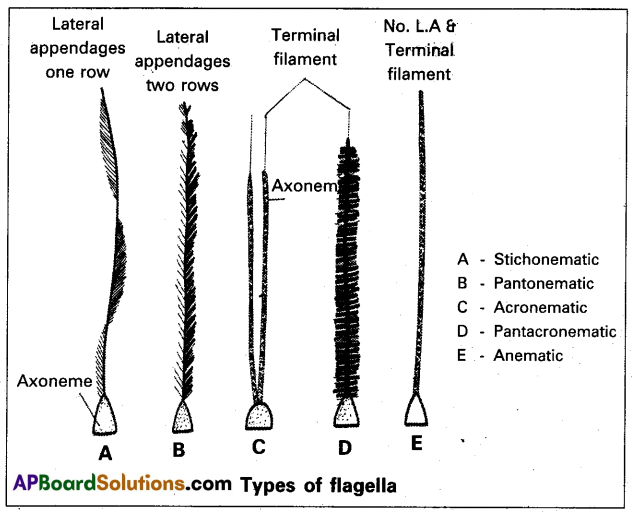
d) Pantacronematic : This type of flagellum is provided with two or more rows of lateral appendages and the axoneme ends in a terminal naked filament.
E.g. Urceolus.
e) Anematic or simple : In this type of flagellum, lateral appendages and terminal filament are absent. Hence, it is called anematic (a-no;nematic-threads)
E.g. Chilomonas and Cryptomonas.
![]()
Question 15.
Distinguish, between addiction and dependence.
Answer:
Addiction : It is a psychological attachment to certain effects such as euphoria. The most important thing one fails to realise it, the inherent addictive nature of tobacco, drugs and alcohol, with the repeated use of TDA, the tolerance level of the receptors present in our body increases. Consequently the receptors respond only to higher doses leading to greater intake and addiction. However it should be clearly borne in mind that use of TDA even once, can be a fore-runner to addiction. Thus, the addictive potential of tobacco, drugs and alcohol pull the users into a vicious circle leading to their regular use (abuse) from which they may not be able to get out. In the absence of any guidence or counseling, people get addicted and become dependent on them.
Dependence : It is the tendency of the body of manifest a characteristic unpleasant condition (withdrawal syndrome). It the regular dose of drugs or alcohol is abruptly discontinued. The withdraw syndrome is characterised by anxiety. Shakiness (tremors), nausea, and sweating which may be relieved when the regular use is resumed again. Dependence leads the patients to ignore all social norms.
Question 16.
Draw a neat labelled diagram of the salivary apparatus of cockroach.
Answer:

Question 17.
Describe the structure and function of the heart in periplaneta with the help of a neat labelled diagram.
Answer:
Heart : The heart lies in the pericardial haemocoel or dorsal sinus. It is a long muscular, contractile tube found along the mid dorsal line, beneath the terga of the thorax and abdomen. It consists of 13 chambers. Every chamber opens into the other present in front of it. Three of the thirteen chambers are situated in the thorax and ten in the abdomen. Its posterior end is closed while the anterior end is continued forward as the anterior aorta. At the posterior side of each chamber, except the last, there is a pair of small apertures called ‘Ostia’ one on each side. Ostia have valves which allow the blood to pass only into heart from the dorsal sinus.

Question 18.
How do marine animals adapt to hypertonic sea water ?
Answer:
To overcome the problem of water loss, marine fishes have aglomerular kidneys with less number of nephrons. Such kidneys minimize the loss of water through urine. To compensate water loss the marine fish drink more water and along with this water, salts are added to the body fluids and disturb the internal equilibrium. To maintain salt balance (salt homeostasis) in the body they have salt secreting chloride cells in their gills. Marine birds like sea gulls and penguins eliminate salts in the form of salty fluid that drips through their nostrils. In turtles the ducts of chloride secreting glands open near the eyes. Some cartilaginous fishes retain urea and trimethylamine oxide (TMO) in their blood to keep the body fluids isotonic to the sea water and avoid dehydration of the body due to exosmosis.
![]()
Section – C (2 × 8 = 16)
Note : Answer any two questions in 60 lines each.
Question 19.
Classify and describe the epithelial tissues on the basis of structural modification of cells with examples.
Answer:
Epithelium (epi-upon ; thelia – growing) forms the outer covering of the body and the living of internal organs and cavities.
There are two types of epithelial tissues namely ‘simple epithelia’ and ‘compound epithelia’ based on the number of layers or strata.
Simple epithelium is composed of a single layer of cells and forms the lining of body cavities, ducts and vessels. It helps in diffusion, absorption, filtration and secretion of substances. On the basis of the shape of the cells, it is further divided into three types :
i) Simple squamous epithelium (Pavement epithelium): It is composed of a single layer of flat and tile-like cells, each with a centrally located ‘ovoid nucleus’. It is found in endothelium of blood vessels, mesothelium of body cavities (pleura, peritoneum, and pericardium), wall of Bowman’s capsule of nephron, lining of alveoli of lungs etc.
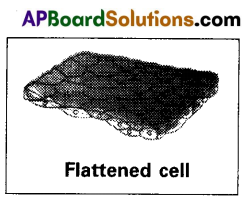
ii) Simple cuboidal epithelium :
It is composed of a single layer of cube-like cells with centrally located spherical nuclei. It is found in germinal epithelium, proximal and distal convoluted tubules of nephron. Cuboidal epithelium of proximal convoluted tubule of nephron has ‘microvilli’.
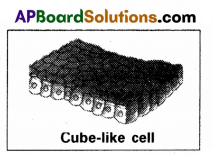
iii) Simple columnar epithelium :
It is composed of a single layer of tall and slender cells with oval nuclei located near the base. It has mucus- secreting goblet cells’ in some places. It is of two types :

a) Ciliated columnar epithe-lium: Columnar epithelial cells have cilia on their free surface. It is mainly present in the inner surface of hollow organs like fallopian tubes, ventricles of brain, central canal of spinal cord, bronchioles, etc.
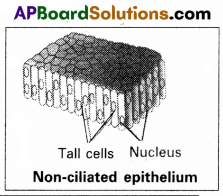
b) Non-ciliated columnar epithelium : Columnar cells are without cilia. It is found in the lining of stomach and intestine. Microvilli are present in the columnar epithelium of intestine to increase the surface area of absorption.
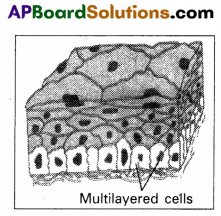
B) Compound epithelium (stratified epithelium): It is made up of more than one layer of cells.
Its main function is to provide protection against chemical and mechanical stress. It covers the dry surface of the skin as stratified, keratinized, squamous epithelium.
It covers the moist surface of buccal cavity, pharynx, oesophagus and vagina as stratified non-keratinized squamous epithelium. It forms the inner lining of the larger ducts of salivary glands, sweat glands and pancreatic ducts as stratified cuboidal epithelium. It forms the wall of the urinary bladder as transitional epithelium.
C) Glandular epithelium :
Some of the columnar or cuboidal cells that get specialised for the production of certain secretions, form glandular epithelium. The glands are of two types – unicellular glands consisting of isolated glandular cells such as goblet cells of the gut, and multicellular glands, consisting of clusters of cells such as salivary glands. On the basis of the mode of pouring of their secretions, glands are divided into two types namely exocrine and endocrine glands. Exocrine glands are provided with ducts; secrete mucus, saliva, earwax (cerumen), oil, milk, digestive enzymes and other cell products. In contrast, endocrine glands are ductless and their products are ‘hormones’, which are not sent out via ducts, but are carried to the target organs by blood. Based on the mode of secretion, exocrine glands are further divided into i. merocrine glands (e.g. : pancreas) which release the secretory granules without the loss of other cellular material.
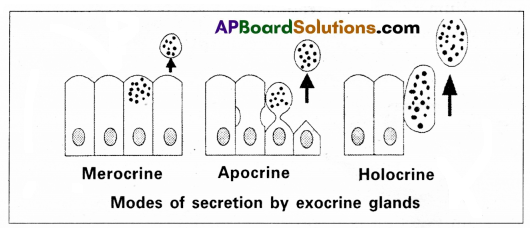
ii. Apocrine glands (e.g. : mammary glands) in which the apical part of the cell is pinched off along with the secretory product and iii. Holocrine glands (e.g. : sebaceous glands), in which the entire cell disintegrates to discharge the contents.
![]()
Question 20.
Describe the life cycle of Plasmodium vivax in mosquito.
Answer:
Life cycle of plasmodium in mosquito (The mosquito phase) Ross cycle :
When a female Anopheles mosquito bites and sucks the blood of a malaria patient the gametocytes along with the other stages of the erythrocytic cycle reach the crop of mosquito. Here all the stages are digested except the gametocytes. Further part of the life cycle consists of
i) Gametogony
ii) Fertilization
iii) Formation of ookinete & oocysts
iv) Sporogony.
i) Gametogony: The formation of male and female gametes from the gametocytes is called gametogony. It occurs in the lumen of the crop of mosquito.
Formation of male gametes :
During this process the nucleus of microgametocyte divides into eight daughter nuclei called pronuclei which reach the periphery. The cytoplasm is pushed out in the form of eight flagella like processes. Into each flagellum like process one pronucleus enters and forms a micro gamete or male gamete. These male gametes show lashing movements like flagella and get separated from the cytoplasm of microgametocyte. This process is called exflagellation.
Formation of female gamete :
The female gametocyte undergoes a few changes and transforms into a female gamete. This process is called maturation.
The nucleus of the female gamete moves towards the periphery and the cytoplasm at that point forms a projection. This projected region is called the fertilization cone.

Fertilization :
The fusion of male and female gametes is called fertilization. It also occurs in the lumen of the crop of the mosquito. When an actively moving male gamete comes into contact with the fertilization cone of the female gamete, it enters it, the pronuclei and cytoplasm of these two gametes fuse with each other, resulting in the formation of a synkaryon. Since the two gametes are dissimilar in size this process is known as anisogomy. The female gamete that bears the synkaryon is called the zygote which is round and non-motile.
iii) Formation of ookinete and oocysts : The zygote remains inactive for some time and then transforms into a long, slender, motile, vermiform ookinete or vermicule with in 18 to 24 hours. It pierces the wall of the crop and settles beneath the basement membrane. It becomes round and secretes a cyst around its body. This encysted ookinete is now called oocyst. About 50 to 500 oocysts are formed on the wall of the crop and appear in the form of small nodules.
iv) Sporogony : The formation of sporozoites in the oocysts is called sporogony. According to Bano, the nucleus of the oocyst first undergoes reduction division followed by repeated mitotic divisions resulting in the formation of about 1,000 daughter nuclei. Each bit of nucleus is surrounded by a little bit of the cytoplasm and transforms into a sickle shaped sporozoite. Oocyst with such sporozoites is called sporocyst.
When this sporocyst reptures, the sprrozoites are liberated into the haemocoel of the mosquito. From there, they travel into the salivary glands and are ready for infection. The life cycle of plasmodium in mosquito completes in about 10 to 24 days.
![]()
Question 21.
Describe lake as an ecosystem giving examples for the various zones and the biotic components in it.
Answer:
Deep water lakes contain three distinct zones namely
i) Littoral zone,
ii) limnetic zone and
iii) profundal zone.
Littoral Zone : It is the shallow part of the lake closer to the shore. Light penetrates up to the bottom. It is euphotic (having good light) has rich vegetation and higher rate of photosynthesis, hence rich in oxygen.
Limnetic Zone : It is the open water zone away from the shore. It extends up to the effective light penetration level, vertically. The imaginary line that separates the limnetic zone from the profundal zone is known as zone of compensation/ compensation point light compensation level. It is the zone of effective light penetration. Here the rate of photosynthesis is equal to the rate of respiration. Limnetic zone has no contact with the bottom of the lake.
Profundal Zone: It is the deep water area present below the limnetic zone and beyond the depth of effective light penetration. Light is absent. Photosynthetic organisms are absent and so the water is poor in oxygen content. It includes mostly the anaerobic organisms which feed on detritus.
The organisms living in lentic habitat are classified into pedonic forms, which live at the bottom of the lake and those living in the open waters of lakes, away from the shore vegetation are known as limnetic forms.
Biota (animal and plant life of a particular region) of the littoral zone : Littoral zone is rich with pedonic flora (especially up to the depth of the effective light penetration). At the shore proper emergent vegetation is abundant with firmly fixed roots in the bottom of the lake and shoots and leaves are exposed above the level of water. These are amphibious plants. Certain emergent rooted plants of littoral zone are the cattails (Typha), bulrushes (scirpus) arrowheads (sagittaria),. Slightly deeper are the rooted plants with floating leaves, such as the water lilies (Nymphaea), Nelumbo, Trapa, etc., still deeper are the submerged plants such as Hydrilla – Chara, potamogeton, etc…. The free floating vegetation includes pistia, wolffia, Lemna (duck weed), Azolla, Eichhomia etc.
The phytoplankton of the littoral zone composed of diatoms (Coscinodiscus, Nitzschia, etc) green algae (Volvox, spirogyra etc), euglenoids (Euglena, phacus, etc) and dinoflagellates (Gymnodinium, Cystodinium, etc ….)
Animals, the consumers of the littoral zone, are abundant in this zone of the lake, these are categorized into zooplankton, neuston, nekton, periphyton, and benthos. The Zoo-plankton of the littoral zone consists of water fleas such as Daphnia, rotizers and ostracods.
The animals living at the air-water interface constitute the neuston. They are of two types. The epineuston and hyponeuston. Water striders (Gerris), beetles, water bugs (Dineutes) form the epineuston/supraneuston and the hyponeuston/infraneuston includes tlie larvae of mosquitoes.
The animals such as fishes, amphibians, water-snakes, terrapins, insects like water scorpion (Ranatra), back swimmer (Notonecta), driving beetles (Dytiscus), capable of swimming constitute the nekton.
The animals that are attached to / creeping on the aquatic plants, such as the ‘water snails’, nymphs of insects, bryozounsa, turbellarians, hydras etc, constitute the periphyton.
The animals that rest on or move on the bottom of the lake constitute the ‘benthos’, e.g.: red annelids, chironomid larvae, cray fishes, some isopods amphipods, clams etc.
Biota of the limnetic zone: Limnetic zone is the largest zone of a lake. It is the region of rapid variations of the level of the water, temperature, oxygen availability etc., from time to time. The limnetic zone has autotrophs (photosynthetic plants) in abundance. The chief autotrophs of this region are the phytoplankton such as the euglenoids, diatoms, cyanobacteria, dinoflagellates and green algae. The consumers of the limnetic zone are the zooplanktonic organisms such as the copepods, Fisher frogs, water snakes etc., form the limnetic nekton.
Biota of the profundal zone: It includes the organisms such as decomposers (bacteria), chironomid larvae, Chaoborus (phantom larva), red annelids, clams etc., that are capable of living in low oxygen levels. The decomposers of this zone decompose the dead plants and animals and release nutients which are used by the biotic communities of both littoral and limnetic zones.
The lake ecosystem performs all the functions of any ecosystem and of the biosphere as a whole, i.e., conversion of inorganic substances into organic material, with the help of the radiant solar energy by the autotrophs, consumption of the autotrophs by the heterotrophs; decomposition and mineralization of the dead matter to release them back for reuse by the autotrophs (recycling of minerals).